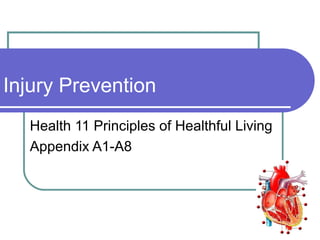
Injury Prevention A1 A8 Fall 2005
- 1. Injury Prevention Health 11 Principles of Healthful Living Appendix A1-A8
- 2. Injury Prevention Morbidity/Mortality in the U.S. Leading Killers & Causes of Disability Recognizing Emergencies The Cardiac Chain of Survival Emergency Action Steps (check,call,care) Rescue Breathing/CPR/Choking Other Preventable Accidents
- 3. Injury Prevention Intentional versus Unintentional Injuries Major Public Health Problem in U.S. Unintentional Injuries are the leading cause of death for the population under 44 years old Accidents are the 5th leading cause of death in this country
- 4. Vehicle Safety 16-24 years old highest death rate Inexperience and Immaturity In 2002, 38,309 died in auto crashes Each year 1.9 million are disabled (140,000 permanently) Prevention: Risk Management 1 car length for every 10mph, constantly scan around you for new variables (drivers, road conditions, weather, signs), drive w/low beams, drive refreshed/sober, obey traffic laws, use seat belts, AAA accident-avoidance techniques, when buying a car look for safety technology, stay in car when in breaks down
- 5. Pedestrian Safety 13% of all motor vehicle deaths involve pedestrians 82,000 pedestrians injured each year Very young & elderly have the highest death rates High risk situations – after dark, urban setting, intersections w/blind corners Alcohol not a variable Prevention – wear reflective material/clothing, cross only at crosswalks, look both ways, watch for turning cars, walk facing traffic, don’t wear headphones
- 6. Cyclist safety 63 million Americans ride bikes 800 cyclists die each year Biggest risk factors – not wearing a helmet (ANSI approved), riding after dark, children 10-14 years highest risk for injury, 87% of fatal collisions are due to cyclist error – failure to yield, alcohol plays a significant role in cyclists death/injuries Prevention – wear a helmet (ANSI approved), 85% of head trauma due to not wearing a helmet, don’t drink & ride, respect traffic, don’t assume right of way, know and use proper hand signals, keep bicycle in proper working condition, ride w/the flow of traffic, use bike paths when you can, same laws apply to drivers and cyclist so share the road, stop at stop signs and red lights
- 7. Water safety 3rd most common cause of accidental death 85% of victims are teenage males Usually strong swimmers but they choose bad situations Risk factors – alcohol consumption, unorganized, unsupervised conditions, swimming alone, diving into shallow, murky water Prevention – don’t drink alcohol and swim, you should be able to swim at least 50 feet unassisted, know your limitations, never swim alone, don’t leave children/infants unattended in water (pools or bath tubs) even if it is shallow you can drown in 1” of water, most neck and back injuries result from diving into shallow water, careful when getting into a pool or other water source if it is raining so hard you can’t see the bottom of the pool, river currents. If you have a pool party hire a lifeguard. Awareness of people who have conditions where they might lose consciousness (epileptics, diabetics, drug use)
- 8. Top 10 Killers in U.S. 1997 1. Heart Disease 31.4% 2. Cancer 23.2% 3. Stroke 6.9% 4. COPD 4.7% 5. Accidents 4.1% 6. Pneumonia/Influenza 3.7% 7. Diabetes 2.7% 8. Suicide 1.3% 9. Kidney Disease 1.1% 10. Chronic Liver Disease and Cirrhosis 1.1%
- 9. Heart Attack Signals Pale, clammy, SOB Faint, anxious, feeling that death is imminent Tachycardia, thready pulse, low BP Chest pain > 2 min. Radiating pain, pressure, discomfort in arm, jaw and back EKG might detect elevation of ST segment and Q wave ALOC – altered level of consciousness measured using Glasgow Coma Scale Nausea/Vomiting Gastrointestinal Distress Activate E.M.S. as soon as possible. Forty percent of people die within the first hour of a heart attack.
- 10. Heart Attack Trivia 70% of heart attacks take place at home 30% of heart attacks outside of home Most heart attacks occur Monday mornings Men and post-menopausal women are at highest risk Men deny they are having a heart attack Women are treated for gastric or gynecology problems – treatment delayed because women present different s/s for heart attacks – Women’s Health Initiative 1991
- 11. The Cardiac Chain of Survival The United States Chain of Survival has 4 links: 1. Early Recognition and access 911 2. Early CPR 3. Early Defibrillation 4. Early ACLS The Canadian Chain of Survival has 7 links: 1. Healthy Habits – prevention of risk factors 2. Recognition of problem 3. Early 911 4. Early CPR 5. Early Defibrillation 6. Early ACLS 7. Early Rehabilitation
- 12. Adult, Child, Infant CPR Key point: supply what is missing A – airway (head tilt, chin lift) B – breathing(10cc/kg/min) C – circulation(30 compressions: 2 breaths) D – defibrillation Adult and Child Only – Do Not Use AED on Infants (“I’m clear, your clear, we’re all clear”) AED will shock for 2 rhythms 1. ven. Fib 2. pulseless ven. Tach.
- 13. Emergency Action Steps Check check the scene, then check victim Call have someone call 911 and have them get back to you – make eye contact Care ABC’s – A=airway, B=breathing, C=circulation
- 14. Primary / Secondary Survey Primary Survey – ABC’s – This is YOUR job when you are CPR certified Secondary Survey – Head to Toe check This is your job if you are First Aid certified or an EMT or paramedic or advanced medical personnel
- 15. Reasons to STOP CPR When the scene becomes unsafe You detect signs of circulation An AED becomes available You are too exhausted to continue Another trained person takes over CPR EMS personnel arrive and take over
